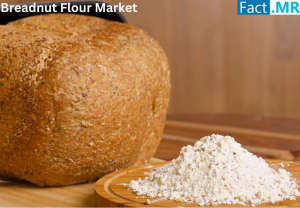Breadnut Flour Market is Expected to Reach USD 115.0 Million by 2035 | FactMR Report
Explore the rising demand for breadnut flour: its nutritional and functional qualities, growth drivers, regional trends, challenges, and outlook through 2035.
ROCKVILLE, MD, UNITED STATES, October 3, 2025 /EINPresswire.com/ -- The global breadnut flour market is projected to grow from USD 42.0 million in 2025 to approximately USD 115.0 million by 2035, recording an absolute increase of USD 73.0 million over the forecast period. This translates into a total growth of 173.8%, with the market forecast to expand at a compound annual growth rate (CAGR) of 10.6% between 2025 and 2035.What is Breadnut Flour?
Breadnut flour is derived from the seeds of Artocarpus camansi (commonly called the breadnut), a tropical fruit whose seeds are rich in carbohydrates, fiber, and protein. Research has shown that breadnut flour demonstrates favorable functional properties such as water and fat absorption, emulsion capacity, and foaming ability. When blended with wheat flour, it provides good baking quality while delivering nutritional benefits. With about three-quarters of its composition as carbohydrates, along with fat, protein, and antioxidants, breadnut flour is emerging as a valuable ingredient in the functional foods category.
Drivers of Market Growth
Growing health and nutrition awareness is one of the strongest drivers of this market. Consumers today are increasingly seeking alternative flours that offer higher fiber, better digestibility, and antioxidant capacity. Breadnut flour, with its gluten-reduced nature, fits neatly into this demand for healthier options. Dietary diversification is another important factor. The rising interest in plant-based diets, the revival of traditional crops, and the shift toward regional food diversity have created a natural opportunity for breadnut flour to be adopted as a staple or supplement.
The clean-label trend is adding further momentum. Shoppers want foods that are natural, minimally processed, and free from artificial additives. Breadnut flour aligns perfectly with this demand while also adding value in terms of texture and performance when mixed with other flours. On the agricultural side, breadnut cultivation supports sustainable farming. As a tree species, breadnut contributes to soil conservation and agroforestry, offering resilience to tropical farming systems while opening up new income sources for farmers.
Regional Trends
The breadnut flour market will develop differently across regions. Southeast Asia and the Pacific Islands are expected to lead in both production and consumption, thanks to the natural presence of breadnut and the growing awareness of its nutritional benefits. Latin America and the Caribbean show strong potential as well, particularly where traditional knowledge of similar native species already exists. Western markets, including North America and Europe, will likely experience growth through niche food sectors such as health and wellness, specialty bakery, and gluten-reduced product lines. Here, breadnut flour may enter mainly as a blending ingredient in premium formulations.
Challenges and Restraints
The journey of breadnut flour toward wider adoption is not without hurdles. One key restraint is the limitation of supply chains and cultivation. Breadnut trees are not as widely farmed as major crops like wheat, so building reliable production at scale remains a challenge. Processing and cost issues also need attention. The dehulling, drying, and milling process for breadnut seeds is more complex and costly than for conventional grains, which may result in higher retail prices and limit adoption in price-sensitive regions.
Consumer awareness remains a barrier, especially in markets where breadnut is not a traditional food. Acceptance will depend on how well the flour performs in terms of taste, baking qualities, and texture when substituted for or blended with wheat flour. Regulatory challenges are another factor. Establishing proper safety standards, nutritional labeling, and certifications such as organic or allergen-free is crucial for global expansion. Without harmonized standards, entry into larger markets could be delayed.
Full Market Report available for delivery. For purchase or customization, please request here - https://www.factmr.com/connectus/sample?flag=S&rep_id=11110
For more on their methodology and market coverage, visit - https://www.factmr.com/about-company
Market Outlook (2025–2035)
Looking ahead, the breadnut flour market promises strong growth and innovation opportunities. Blended flours that combine breadnut with wheat or other alternatives will play a significant role in gaining market share. Product developers are likely to highlight the nutritional benefits of breadnut flour in functional foods, fortified products, and clean-label bakery lines. Partnerships among growers, processors, and food manufacturers will be critical to building efficient supply chains and ensuring consistent quality.
Regions with traditional use and natural breadnut growth are expected to adopt the flour quickly, while exports to global niche markets will expand steadily. Overall, the rising global demand for sustainable, nutritious, and functional food products makes breadnut flour a strong candidate for inclusion in the next generation of specialty food ingredients.
Key Takeaways
Breadnut flour is gaining attention as a nutritious and functional alternative that appeals to health-conscious and clean-label consumers. At the same time, the market must overcome challenges related to supply, processing costs, and consumer awareness to achieve its full potential.
Check out More Related Studies Published by Fact.MR Research:
Inulin Industry Analysis in East Asia: https://www.factmr.com/report/inulin-industry-analysis-in-east-asia
Buttermilk Powder Market: https://www.factmr.com/report/buttermilk-powder-market
Bromelain Market: https://www.factmr.com/report/bromelain-market
Inulin Industry Analysis in North America: https://www.factmr.com/report/inulin-industry-analysis-in-north-america
Editor’s Note:
This release is based exclusively on verified and factual market content derived from industry analysis by FactMR. No AI-generated statistics or speculative data have been introduced. This story is designed to support manufacturers, healthcare providers, and wellness brands in recognizing the Breadnut Flour industry as a major growth and innovation sector for the coming decade.
S. N. Jha
Fact.MR
+1 628-251-1583
sales@factmr.com
Legal Disclaimer:
EIN Presswire provides this news content "as is" without warranty of any kind. We do not accept any responsibility or liability for the accuracy, content, images, videos, licenses, completeness, legality, or reliability of the information contained in this article. If you have any complaints or copyright issues related to this article, kindly contact the author above.

